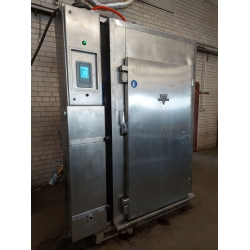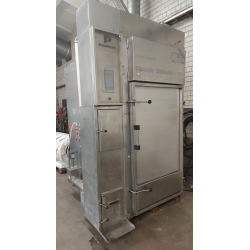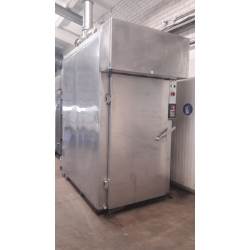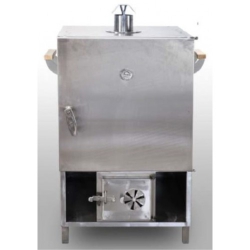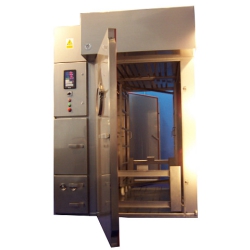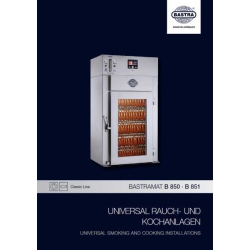Smoke chamber
A smokehouse is a system that regulates air flows. In a universal smokehouse, one production process replaces another, so the air flows change frequently. Airflows can be closed (circulating inside the smoker) or open (where air is blown into the smoker). These air flows are regulated by pneumatic air inlet and outlet valves built into the air control ducts.
The cooking mode in the smoker is created by injecting heated steam or water inside it. The cooking function allows you to perform a complex product processing operation without removing the products from the smoker.
A very important element of the smoker is the smoke generator. There are different types of smoke generators, the most popular of which are smoldering (fired with sawdust), friction (smoke is produced by rubbing...
A smokehouse is a system that regulates air flows. In a universal smokehouse, one production process replaces another, so the air flows change frequently. Airflows can be closed (circulating inside the smoker) or open (where air is blown into the smoker). These air flows are regulated by pneumatic air inlet and outlet valves built into the air control ducts.
The cooking mode in the smoker is created by injecting heated steam or water inside it. The cooking function allows you to perform a complex product processing operation without removing the products from the smoker.
A very important element of the smoker is the smoke generator. There are different types of smoke generators, the most popular of which are smoldering (fired with sawdust), friction (smoke is produced by rubbing wood) and steam (smoke is produced by heated steam). Smoke generators can be simple or circulating. Simple smoke generators have one channel for smoke supply to the smoking chamber. Circulating smoke generators have channels for smoke supply and air extraction from the smoking chamber.
Modern smokehouses have computer controlled systems. Such a complex management of the smokehouse is necessary because the smoking process is not homogeneous, but consists of separate stages. As an example, let's consider a program for preparing smoked sausages, consisting of the following programmable parts:
- product surface temperature equalization,
- product surface drying,
- smoking,
- intermediate smoking cessation, temperature equalization,
- smoking,
- cooking
Different parameters are set for each of these operations - temperature, humidity, smoke intensity and time. A company that produces many products uses many programs, each of which has a description with smoking, cooking and drying modes, temperatures and other data. The programs are prepared by the company's technologists. It is important that the established program regimes are strictly followed under conditions of intensive production. Computer controlled smokehouses simplify this task. Programs for smoking and cooking products are stored in computer memory and given numbers or names. All that remains for the workshop staff is to select the required program and run it. This simplifies management and accurately follows thermal processing regimes.
Thermal processing of products requires energy, which means that processed products lose weight. The more energy is wasted in the smoker, the more the weight of the product is lost. Designers of smokehouses have a clear goal - the smokehouse must process products using as little energy as possible. To achieve this goal, closed smoking systems are being developed. The essence of a closed smoking system is that the smoking and cooking processes take place without supplying atmospheric air to the system. Air flows in the smokehouse circulate in a closed circle. The smoke produced inside the chamber enters the smoke generator, where it is saturated and enters the chamber again. Such equipment consumes less energy, and products lose less weight. A small amount of atmospheric air is needed to dry the products (the ratio of atmospheric to indoor air is 1:3). Atmospheric air is needed to reduce the amount of moisture inside the chamber and to dry the surface of the product. In order to make the drying process as short as possible and to reduce weight loss, the temperature equalization program is automatically activated before drying. During it, additional heat is injected into the chamber for a short time so that the surface temperature of all the products in the chamber rises slightly and becomes uniform. This avoids possible condensation of moisture on the surface of the products.
The drying program must be short. Drying for too long consumes more energy, and an overdried product surface degrades quality. And in other stages of thermal processing of products, it is important that products are not processed for too long. An optimization program can be run on the smoker's computer to find the optimal processing time. The computer graphically compares the prepared working program with the calculated parameters. In this way, technologists find the optimal solution in each specific case.

